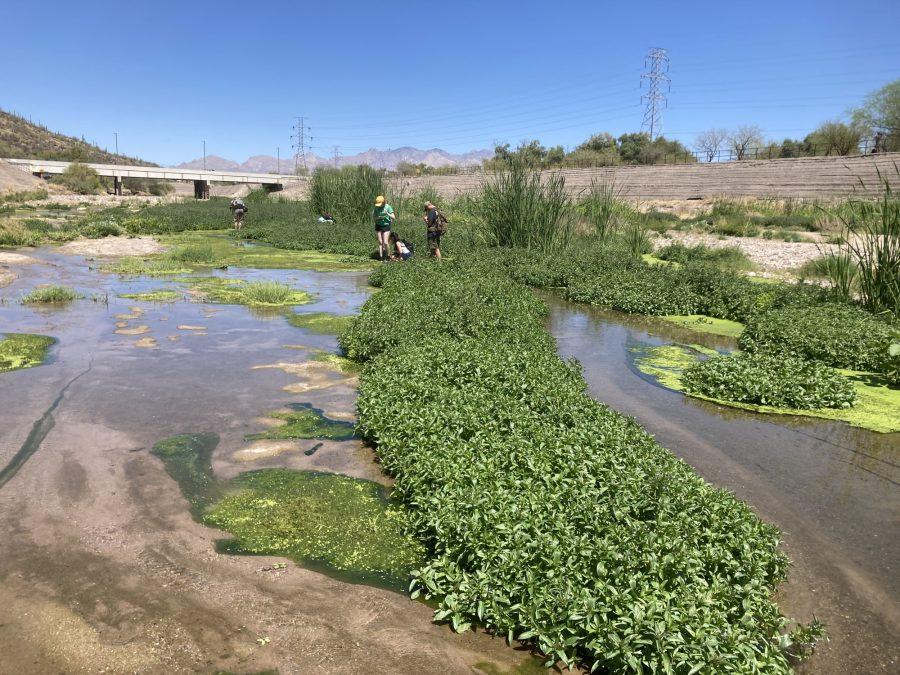Just south of downtown Tucson, residents can visit a flowing river that’s become a vibrant green habitat home to fish, birds and insects.
The Santa Cruz River was historically used for irrigation and by Indigenous people in the area for centuries. But as Natalie DeRoock, Tucson Water’s public information officer explained, at the turn of the 20th century, the river dried up as the water was drawn out of the river and out of the aquifer underneath Tucson. The river, once home to a flourishing riparian ecosystem, has been nothing more than an empty stream bed for decades.
In recent years, water has returned to some portions of the river. Where there is water, there is life, leaving green brushstrokes in downtown Tucson and other areas where water has returned to the river. The water has been brought back by Tucson Water, which provides water to the city of Tucson.
RELATED: The Health Science Center will expand new research opportunities to address addiction
The city of Tucson gets its drinking water from the Central Arizona Project, which brings water from the Colorado River to the city via a canal. For centuries, Tucson’s main groundwater source has been its aquifer, but today all the water that comes out of Tucsonan’s sinks and shower-heads is water from the CAP.
DeRoock explained that “we are bringing that water in to provide water for Tucson and its growing needs, but also to recharge the aquifer,” which will be critical for the long-term sustainability of the city, especially as drought continues in the Southwest.
Tucson is unique because it has no surface water. Other cities have access to lakes or reservoirs (think of Tempe Town Lake in Phoenix or Lake Mead for Las Vegas). DeRoock emphasized that by nature, Tucson has to be at the forefront of water conservation. That involves encouraging residents to be water-wise, like taking shorter showers, watering your plants with the greywater from washing your dishes or using low-water landscaping and reuse wastewater.
Tucson Water provides treated wastewater for watering golf courses and lawns. The utility also uses wastewater to recharge the aquifer, the underground storage pool of groundwater that can be used as a water source. A century of over-utilization has drained the aquifer, so Tucson Water hopes to recharge it.
RELATED: France-Arizona Institute for Global Grand Challenges panel discusses land conservation efforts
DeRoock explained the process of recharge. Wastewater, or effluent, is treated almost to the point of being drinkable before being used for recharge. Currently, Tucson Water runs three recharge projects: Sweetwater Wetlands, the new South Houghton Area Recharge Project and the Santa Cruz River Heritage Project near downtown. These projects use treated wastewater to create riparian habitats, and DeRoock explained that “in doing so, once that water is released, it trickles back down and infiltrates back into the aquifer.”
Beyond acting as a recharge facility, the Santa Cruz River Heritage Project does double-duty to provide an economic and environmental resource for Tucson.
Michael Bogan, an assistant professor in the School of Natural Resources and the Environment at the University of Arizona, noted that “there’s been study after study showing that people’s attitudes and desires are to live near water, and so just having the water down there itself is a benefit to the residents who live in that area.”
Additionally, the water in the river draws in birds, which in turn draws in bird watchers, bringing tourism to Tucson. For Bogan, an aquatic ecologist, the river and the Santa Cruz River Heritage Project also provides research opportunities.
“When I went down the first day of the [water] releases [into the river] and saw the dragonflies and the damselflies that had already found the water. I thought, ‘well okay, we’re gonna study this somehow,’” Bogan said.
RELATED: Smart drug delivery technology
Students and researchers from the university work alongside scientists from Pima County, the city of Tucson and the Arizona Game and Fish Department. Bogan explained that the Santa Cruz River Heritage Project is a unique opportunity to do science where the results can be immediately used, rather than publishing a paper that’s only read by others in the field. Bogan can work with Tucson Water to change aspects of the water releases to better support the flora and fauna in the river, using the results of his research.
At the Santa Cruz River Heritage Project, located where the river and 22nd Street intersect, around 1,200 gallons of water are released into the river per minute, according to DeRoock. This recreates a flowing river, creating a riparian habitat for plants and animals that have long been absent from downtown Tucson. The result is striking: a bright green ribbon winding underneath Sentinel Peak. Visitors can see schools of fish swimming along the river bottom, listen to a diverse choir of birds and watch brightly colored dragonflies dance around the vegetation.
Follow Hannah Johnson on Twitter









